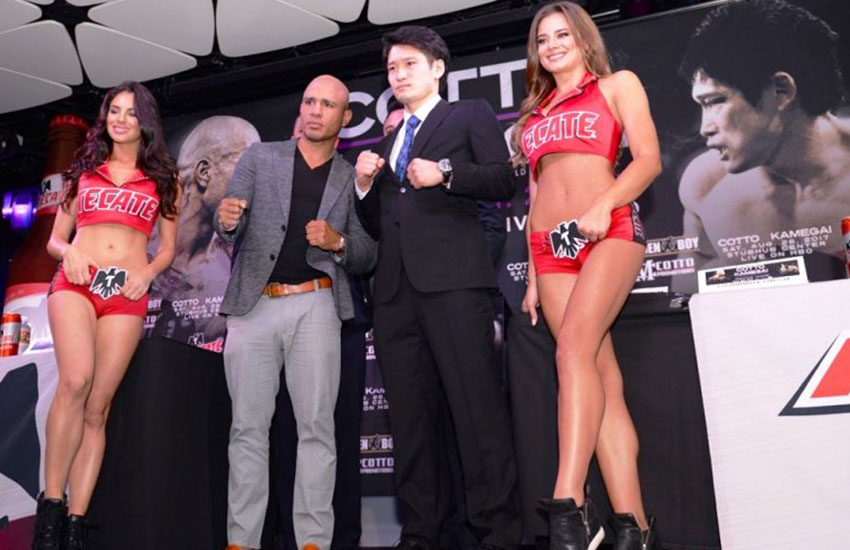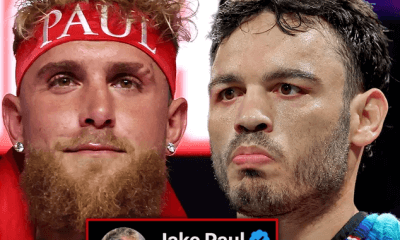Featured Articles
Upset Time for Miguel Cotto vs. Yoshihiro Kamegai in L.A.?

Sixteen years have passed since Puerto Rico’s Miguel Cotto stepped foot in a prize ring in the Los Angeles area.
In 2001, Cotto was unknown to the Southern Californians. Most only knew he participated in the Olympics in Australia. His former promoter boldly claimed he would be one of the greats. This was during Felix “Tito” Trinidad’s era and that was a pretty lofty statement.
Cotto (40-5, 33 KOs) returns to L.A. for perhaps his farewell performance against Japan’s under-rated Yoshihiro Kamegai (27-3-2, 24 KOs) for the vacant WBO super welterweight world title on Saturday Aug. 26, at the StubHub Center in the metropolitan L.A. municipality of Carson. HBO will televise.
A lot has changed in 16 years for Cotto. First, the Puerto Rican no longer sports hair and no longer are there questions about his fighting abilities. Now, 36, he’s conquered the lightweight, super lightweight, welterweight, super welterweight and middleweight divisions.
Not even the great “Tito” Trinidad was able to accomplish that feat.
During that first L.A. appearance Cotto was a marauding 135-pounder with a seek-and-destroy style that was overwhelming for his Mexican opponent that night Arturo Rodriguez. But the match-making was built to make Cotto look good in his sixth pro fight.
That same night Roy Jones Jr. would dominate against Julio Gonzalez in a unification bout for the light heavyweight world title. It was Jones first and only appearance in L.A. too and he would easily vanquish the Mexican fighter by decision.
Sadly, Gonzalez passed away in 2012 from a motorcycle accident in Mexico. He was the first and only pro boxer from Orange County to win a world title. We will talk about him later.
Cotto turned out to be much more than what was expected. Yes everyone could see he had power, speed and impressive fighting skills. But over the years the Puerto Rican from Caguas proved to be one of the most intelligent and business smart boxers in the last 20 years.
Ever since breaking away from his uncle and trainer Evangelista Cotto he has searched for the perfect coach. He had successful ventures with Emanuel Steward, Pedro Diaz, and then decided on Freddie Roach in 2013. They clicked immediately and have not looked back.
That’s the way Cotto maneuvers. He’s as deft in the business side as he is in the boxing ring.
Whenever Cotto fights it’s by his own design and his own terms. And always it’s the most money he can make at the proper moment.
“We are going to do what we always do, pick and choose the best challenger out there,” said Cotto.
When he fought Floyd Mayweather it was his own choosing and with the promoter of his choice. It was the same when he fought Sergio Martinez and Saul “Canelo” Alvarez but skipped Gennady Golovkin. Cotto knows exactly who to fight and when to fight them.
Now he faces Kamegai.
Two Faces of Kamegai
If you know anything about Japan you know it’s a nation that prides itself on producing warriors. But like other countries you can’t typecast their fighters.
Kamegai fought for years in Japan but had often wondered how it would be to face some of the big names in the U.S.
His first visit to the U.S. was on a 2011 card filled with two other talented Japanese fighters including IBF super bantamweight titlist Toshiaki Nishioka who would defeat Mexico’s Rafael Marquez and retain the title in Las Vegas.
Kamegai was on the card and faced Hector Munoz, a battle-tested veteran from New Mexico who had faced many of the top fighters like Shawn Porter and Mike Jones. He was informed what fighting style American fans liked to see.
“In Japan I was more of a technical fighter with good defense. I was aggressive, but I was known for my defenses,” said Kamegai, 34, who was born in Sapporo. “But coming to the States, I knew to win here I had to be more aggressive and be not so technical but a more aggressive fighter.”
Fighting aggressively proved to be great for obtaining fights in the U.S. but despite entertaining clashes against Johan Perez, Robert “The Ghost” Guerrero and Alfonso Gomez, all ended in losses.
Last year Kamegai was matched against Jesus Soto Karass in one of the best fights of 2016. Both banged each other so fiercely that after 10 rounds at Belasco Theater no one in the audience could truly say who won the fight. Oddly enough, it ended in a draw. Many in the audience gave a sigh of relief. None wanted to see either fighter get a loss after a performance like that.
A rematch was signed by the Mexican and Japanese warrior to do it again five months later, this time at the Inglewood Forum.
All those losses piling up must have changed Kamegai’s attitude because the man that lost to Perez, Guerrero, Gomez and drew with Soto Karass did not show up at the Forum last September. Instead, a more slick counter-punching boxer-puncher arrived and blew out Soto Karass into a short retirement.
Kamegai is like a chameleon. He can change according to the fight. So the big question now is: which Kamegai will show up against Cotto?
“I’m here to give the fans what they’re looking for,” said Kamegai. “When I fight in the United States, I’m much more motivated. Especially with the reaction from the fans and the crowd.”
Don’t expect Kamegai to allow Cotto to run away with an easy victory especially with a world title as the reward.
“I enjoy fighting here, and it’s probably the best platform to be fighting at,” Kamegai said.
Orange County
In the semi-main event Santa Ana’s Ronny Rios (28-1, 13 KOs) challenges undefeated Rey Vargas (29-0, 22 KOs) for his hold on the WBC super bantamweight world title. If successful, Rios can be the second from Orange County to hold a world title.
Only the late Julio Cesar Gonzalez can make the claim of being a world champion from Orange County in boxing. Tito Ortiz also held a world title in MMA. Gonzalez won the light heavyweight world title in boxing. Both hailed from Huntington Beach, Calif.
Gonzalez used to train at La Habra Boxing Club along with Enrique Ornelas and Librado Andrade. Anybody who sparred against those three was in for a rough night. They were the Bash Brothers in real life. Back in 2001, Gonzalez became the first fighter of Mexican descent to win a world title above middleweight when he defeated Dariusz Michalczewski by split decision in Germany to win the WBO world title. It was something that not even Roy Jones Jr. dared risk but Gonzalez was more than willing to do. After beating Michalczewski, the likeable Gonzalez was given a unification bout against Jones who was at his peak. It was a one-sided affair but Gonzalez went the distance at the Staples Center in Los Angeles.
Rios, 27, will try to become the second fighter out of OC to have a world title belt. The champion Vargas is 26 and has not fought the same level of competition except in winning the belt versus Gavin McDonnell in February.
To comment on this article at The Fight Forum, CLICK HERE.
Check out more boxing news on video at The Boxing Channel.
-

 Featured Articles4 weeks ago
Featured Articles4 weeks agoAvila Perspective, Chap. 330: Matchroom in New York plus the Latest on Canelo-Crawford
-

 Featured Articles3 weeks ago
Featured Articles3 weeks agoVito Mielnicki Jr Whitewashes Kamil Gardzielik Before the Home Folks in Newark
-

 Featured Articles17 hours ago
Featured Articles17 hours agoResults and Recaps from New York Where Taylor Edged Serrano Once Again
-

 Featured Articles4 weeks ago
Featured Articles4 weeks agoCatching Up with Clay Moyle Who Talks About His Massive Collection of Boxing Books
-

 Featured Articles5 days ago
Featured Articles5 days agoFrom a Sympathetic Figure to a Pariah: The Travails of Julio Cesar Chavez Jr
-

 Featured Articles3 weeks ago
Featured Articles3 weeks agoMore Medals for Hawaii’s Patricio Family at the USA Boxing Summer Festival
-

 Featured Articles7 days ago
Featured Articles7 days agoCatterall vs Eubank Ends Prematurely; Catterall Wins a Technical Decision
-

 Featured Articles4 weeks ago
Featured Articles4 weeks agoRichardson Hitchins Batters and Stops George Kambosos at Madison Square Garden




















